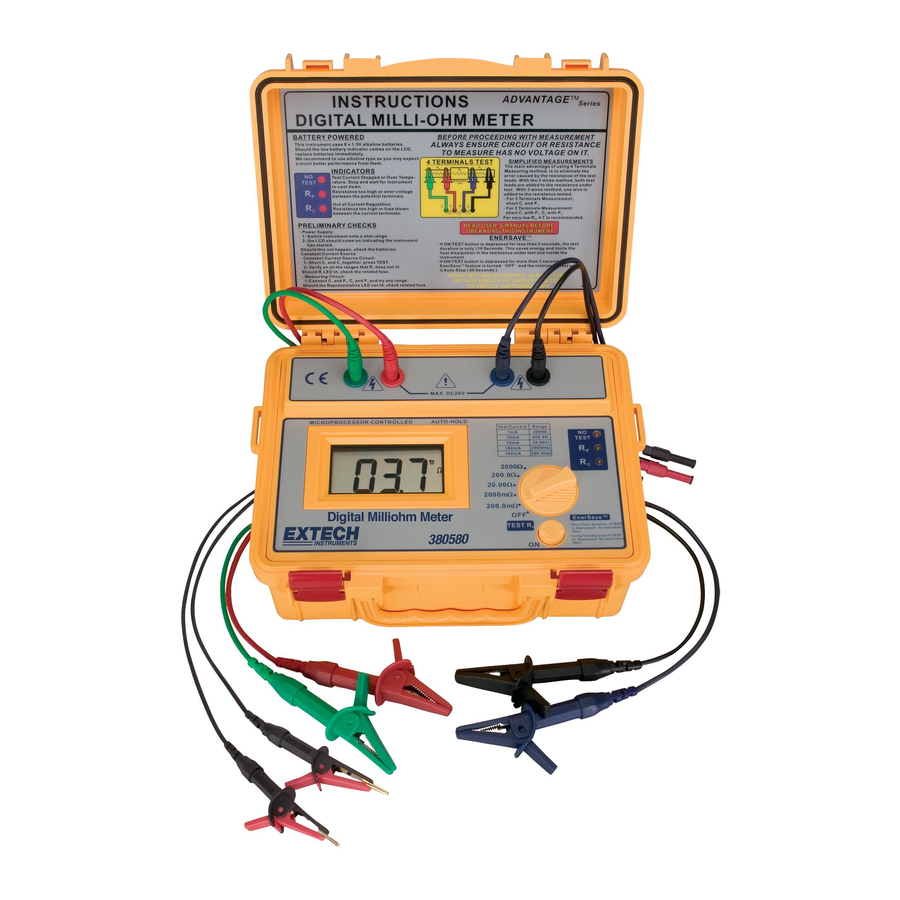
Table of Contents
Advertisement
Quick Links
User's Guide
Model 380580
Battery Powered
Milliohm Meter
Test Equipment Depot - 800.517.8431 - 99 Washington Street Melrose, MA 02176
FAX 781.665.0780 - TestEquipmentDepot.com
Visit us at www.TestEquipmentDepot.com
Back to the Extech 380580 Product Page
99 Washington Street
Melrose, MA 02176
Phone 781-665-1400
Toll Free 1-800-517-8431
Advertisement
Table of Contents

Summary of Contents for Extech Instruments 380580
- Page 1 User’s Guide Melrose, MA 02176 Phone 781-665-1400 Toll Free 1-800-517-8431 Visit us at www.TestEquipmentDepot.com Back to the Extech 380580 Product Page Model 380580 Battery Powered Milliohm Meter Test Equipment Depot - 800.517.8431 - 99 Washington Street Melrose, MA 02176 FAX 781.665.0780 - TestEquipmentDepot.com...
-
Page 2: Specifications
Introduction Congratulations on your purchase of Extech’s Model 380580 Battery Powered Milliohm Meter. This device offers five resistance ranges with resolution as low as 0.1mΩ. The 4-wire Kelvin clip connection ensures optimum accuracy. Typical applications include transformer, motor coil, and PC Board resistance measurements. This professional meter, with proper care, will provide years of safe reliable service. -
Page 3: Measurement Considerations
Meter Description Current Terminals Potential Measurement Terminals LCD Display Start/Stop Test Button Range Select/Power Switch LED Error Lights • No Test/Over Temperature • R Voltage Regulation • R Current Regulation Current/Range Table Leads Current Leads- Banana plug to alligator clip C1- Green C2- Blue Voltage Potential Leads- Banana plug to alligator clip... - Page 4 Preliminary Checks Current Regulation Check Connect the current leads C and C to the meter. Set the function switch to the 200.0mΩ range. Momentarily press the TEST R button. The meter will intermittently beep and R will light Short the current leads C to C The R LED should go off, indicating that the meter...
-
Page 5: Measurement Procedure
Measurement Procedure Select the desired measuring range on the meter. If the resistance of the device is unknown, start with the highest range and work downward. Clip the test leads onto the device under test. Note: When using the 4-wire/4 alligator clip test leads, it is recommended that the current test leads be outside of the potential test leads (as shown in the diagram below). - Page 6 Measurement Principles The test current flows through the resistance from the Current+ (C+) terminal to the Current - (C-) terminal. The P+ and P- (POTENTIAL) terminals measure the voltage drop across the device under test only, thus eliminating the lead and contact resistances. The meter displays the resistance based on the test current and the measured voltage;...
-
Page 7: Battery Installation
BATTERY INSTALLATION WARNING: To avoid electric shock, disconnect the test leads from any source of voltage before removing the battery cover. Turn power off and disconnect the test leads from the meter. Open the rear battery cover by removing two screws (B) using a slotted head screwdriver.












Need help?
Do you have a question about the 380580 and is the answer not in the manual?
Questions and answers
Hello, we are testing the continuity from the Air Terminal to the roof conductor to show it is hooked up even though its visable, in doing these test we just used 2 leads p1 and p2 and got the results 00.2 milli ohms, is this a correct way or must you use all 4 leads even though we have a great reading, is it manditory to use all 4 leads??
It is not explicitly stated whether all 4 leads are mandatory for continuity testing. However, the manual describes a 4-terminal (Kelvin) measurement method using separate current (C+ and C−) and potential (P+ and P−) terminals to eliminate lead and contact resistances for accurate resistance measurement. For precise continuity testing, using all 4 leads is recommended. Using only 2 leads may result in less accurate measurements due to lead resistance.
This answer is automatically generated